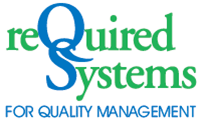Guidance on using the Audit Tool
Required Systems Limited
This tool has been developed with Health and Social Care experts, Care Home Managers and experienced Care Home
Inspectors / Auditors to allow Care Home Owners and Managers to demonstrate how their Care Home meets the requirements
of the Health and Social Care Act 2008 (Regulated Activities) Regulations 2014.
A “Declaration Of Compliance” by each Care Home is required by The Care Quality Commission as part of the registration
and inspection process that all Care Homes and Care Providers must submit before their service can be registered or
rated by CQC.
Each Care Home is required to review their performance, processes, policies and procedures against each relevant
Fundamental Standard and state clearly that they either are “Compliant” or “Non-Compliant”.
Where a Care Home identifies that they are “Compliant”, they should identify the evidence on which their declaration
of compliance is made.
Where a Care Home identifies that they are “Non-Compliant”, they are required to provide a plan of action stating:
- What the non-compliance is
- What action is being taken to become compliant
- How long it will take to become compliant
Established Care Homes should, for the most part, be largely compliant with Standards – although this should not be a
reason for complacency.
There have been a number of changes following the introduction of the Health and Social Care Act 2008 (Regulated
Activities) Regulations 2014 and Care Homes must be able to show that they are aware of these.
If you follow the guidance on the following pages, this tool will provide valuable information to help you through the registration and inspection process. Even if you have already completed the “Compliance Declaration” process, this tool will be a valuable resource for both improvement and preparation for your next inspection from CQC.
How to Use This Tool
Preparation
- Be sure that you are familiar with the Regulations and the Fundamental Standards required to be met.
- Be prepared to be honest in your evaluation of current compliance.
- Be prepared to set some realistic targets for additional work to be done following this compliance declaration exercise.
- Start the completion of this Audit Tool sooner rather than later – it can be done piece at a time over several days (or longer if required), but you must be aware of the “deadlines” for completion which will be set by CQC.
How to Complete This Tool
- You can start with any Regulation you wish – but it makes sense to start at Regulation 4 and work through the tool methodically.
- Look at each individual “Compliance Requirement” in turn. They are a direct reflection of what the Regulations and Standards require you to be able to evidence that you do.
- Try to understand what the “requirement” actually is.
- Try to identify the things that you do, document, train, evidence or promote in your Home.
- The tool provides sample evidence requirements which can be populated into the “Evidence” box which might help.
- You can type additional actions in the “Evidence” box.
- Don’t write things that you “think” or “assume” happen – only the things that you can provide documented proof of. These may include written policies, procedures, records, statements, certificates, photographs or other tangible proof. Don’t include “staff say...” Or “staff should know...”
- Remember, if it is not documented, in the eyes of the inspector it does not exist!
- Evidence of compliance may be quite diverse – many examples are identified in the policies and procedures produced by Required Systems Ltd.
Once You Have Input Your Evidence For Each Regulation
- Each Regulation / Standard may have many component parts and you must review all of the evidence for each component first.
- Decide if you fully comply with that component - if so, move on to the next one.
- If you decide that you do not comply fully with a component, you should try to identify what further action is required to be fully compliant. This is not always easy and you might not be able to provide complete solutions at this stage. It is a good idea to identify what the nature of the shortfall is and an idea of what the solution may be.
-
Once you have completed all the component parts for a Regulation, you should take a balanced view as to whether
the evidence you can produce will constitute “compliance” with that Regulation.
One or possibly two very minor shortfalls are unlikely to affect the registration process but still need to be managed as part of the compliance / registration process. - Remember – it is better to be open about the work you need to do rather than have this pointed out to you at inspection later on.
- Work through each Standard until all have been addressed.
-
As each section is completed you should review the “Further Actions Required” and identify an action plan to
address the shortfalls. Some solutions may be relatively easy, others will not.
What is important is to identify the actions required and plan an achievable timescale for the work to be completed.
Try to avoid setting impossibly tight deadlines – you are just setting up to fail and increasing pressure on yourself.
Avoid giving too much time for action – CQC may not be as relaxed about these timescales as you are!
Review
-
Once the action points have been identified and an action plan has been produced, you should ensure that the
timescales are managed and the improvement activity is reviewed at appropriate times to ensure:
- Actions have happened
- Actions were appropriate
- Improvement has occurred
- The Home is now compliant with requirements
- Where actions have either not happened or the results are still not compliant with requirements, the Manager should review the action plan and ensure that a revised plan is put in place.
